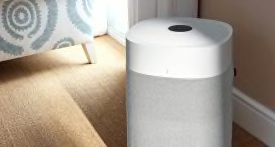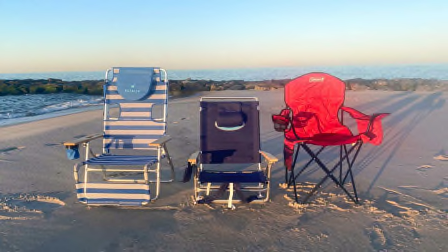Best Beach Canopy for Your Day in the Sun
We evaluated three models for ease of setup, wind resistance, and shade protection, and found one that's a must-have
When you shop through retailer links on our site, we may earn affiliate commissions. 100% of the fees we collect are used to support our nonprofit mission. Learn more.
A beach umbrella is on most people’s lists of summer essentials, and a beach tent is perfect for privacy. But when you want a large amount of shade coverage without blocking any airflow, a beach canopy is the most practical purchase.

Setup time: 1 minute, 52 seconds
Takedown time: 1 minute, 34 seconds
This is the cutest beach canopy around, available in 13 different colors and patterns, such as nautical stripes, florals, and gingham. It was also the easiest to set up and take down, and provided an abundance of shade. Of the three canopies we evaluated, the CoolCabanas CoolCabana 5 was our favorite.
Setup/takedown: Setting up this canopy is a true one-person operation, and the best part? It comes with just three poles and the canopy itself. Remove everything from its roomy carrying bag, which has a shoulder strap and directions attached to the inside of the bag, and insert the pole that has a spike at the end into the sand. Insert another pole on top of the base pole and continue driving it into the sand until you reach the very helpful “sand line” sticker on the middle pole. This tells you that your poles are deep enough to keep the canopy steady. Insert the third pole on top of the middle pole for height, and then simply slide your canopy (unopened) on top of the top pole and gently open the arms so that the canopy fans outward. I say “gently” because if you push too hard on the arms, especially if you’re pushing in the wrong direction, they can break. I know this from experience, but because this was my mistake, I don’t fault the canopy for it. As far as height goes, I’m 5 feet, 7 inches tall and had zero difficulty reaching the top of this canopy during setup. If you’re very petite, you may have some trouble, though.
Your final step is to fill the four sand pockets built into this canopy’s legs with sand to provide stability. Tip: Purchase a small sand shovel to do this swiftly. To take down the canopy, empty the sand pockets by turning them inside out, remove the canopy from the top pole, and gently fold each arm back toward the center pole until it’s compact. Remove the three poles from the sand, place them in their separate smaller carrying bag, and place the canopy and poles back into the main carrying case. This canopy gets bonus points for having a carrying case that’s spacious enough to contain everything.
Shade coverage: The CoolCabana 5 comes in two sizes. We evaluated the medium-sized cabana, which the manufacturer says provides 43 square feet of shade and is ideal for one to two people. The large size, according to the manufacturer, provides 64 square feet of shade and is recommended for families or groups of three or more. There’s no mechanism for tilting the canopy to shield you from the shifting sun.
Wind resistance: I let this canopy stand in the sand for 1½ hours while a light to moderate wind blew, and it barely moved. I can’t vouch for its ability to withstand strong wind gusts, though, and it doesn’t come with stakes to provide additional support.
Features: We love how this canopy features just one center pole (which is actually three small poles that stack on top of one another) because, should you have to shift the canopy, it’s simpler to do than a canopy like the Sun Ninja, which has four poles. The corners of this canopy feature small storage pockets, which is a nice touch, and the fabric feels thick and sturdy. Another cool feature is that you can purchase a separate grass kit if you plan on using this canopy at a park or a backyard barbecue.
According to CoolCabanas, this canopy has been independently tested and shown to provide UPF 50+ protection. CR didn’t assess this claim, and it’s important to apply sunscreen even if you’re relying on protective outdoor shelters like beach umbrellas, canopies, and tents.
What annoyed us: There wasn’t much that annoyed us about this canopy. But if you twisted my arm to create a wish list, it would include a detachable privacy shade that could be used when the sun is set at an angle that this canopy can’t shield against.
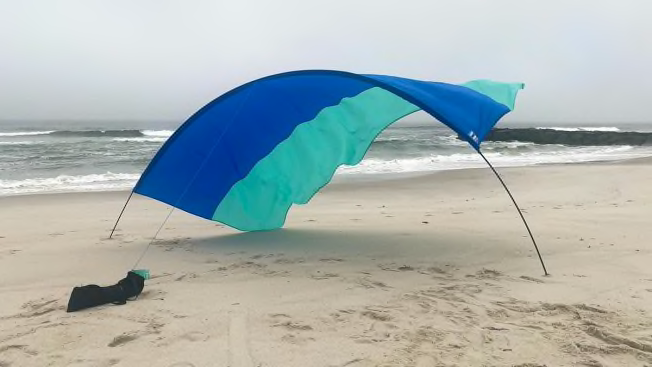
Setup time: 5 minutes, 33 seconds
Takedown time: 1 minute, 28 seconds
While I was setting up the Shibumi Shade Classic on the beach, three people stopped to ask me about it—and this was in April in New York when the beach was mostly deserted. This unconventional wind-powered canopy is a conversation starter, for sure, and it has pros and some cons that make it worth considering.
Setup/takedown: Weighing less than 4 pounds (including every component needed to set it up, as well as the weight of the carrying bag), this is the most lightweight canopy on this list. It consists of just two components packaged in a carrying case with a shoulder strap (with a small instruction booklet attached to the drawstring closure): a lengthy pole that is semi-attached so that it folds down into a compact bundle, and a huge canopy made from 40 percent recycled plastic bottles. Connect the poles first, and then thread the pole through the canopy and secure the canopy on either side with an attached buckle and snap. In theory, this couldn’t be simpler to do. But in reality, when the wind is blowing and you’re doing this alone, possibly surrounded by small children, it can take some patience because the pole and canopy are long. You can get it done solo, but it took me about 6 minutes because one side of the canopy kept slipping toward the middle of the pole while I worked on the other side.
Once the canopy is set on the pole, fill the carrying case (which remains attached to the canopy by a long string) with sand to keep it grounded. Because this canopy is powered by the wind, it should be setup in the direction of the wind. If there’s no wind that day, Shibumi sells a wind assist that attaches to the trailing corners of the canopy to create a tent-like shape. (CR didn’t evaluate this accessory.) Insert one pole into the sand as far down as it can go, and then insert the opposite pole in the sand the same way.
Taking the Shibumi Shade Classic down took a little more than 1 minute: Empty the carry case of sand, pull the opposite ends of the pole out of the sand to lay it flat, and slide the canopy off the pole. Separate the segments of the pole, fold it, and place everything back in the carrying case. The canopy is so thin and lightweight that it isn’t a struggle to get it back into the bag. Note that the dimensions listed above were independently measured. The length of the pole while each segment is connected and the height may differ for you, depending on how far you insert the pole into the sand.
Shade coverage: According to the manufacturer, this canopy provides 150 square feet of shade coverage. But because the wind isn’t always predictable, I observed the shade coverage shift over the course of an hour and a half. Parts of the canopy billowed out and fell on parts of the sand where you could be sitting. Depending on the changing direction of the wind, you may need to remove the two ends of the pole and shift the direction during a beach day.
Wind resistance: The wind blew consistently the morning I set up this canopy, but the poles didn’t budge from the sand once. The canopy doesn’t include stakes, and the company website doesn’t sell attachments to set it up on grass.
Features: We love that the canopy is made with 40 percent recycled plastic bottles. It provides UPF 50+ protection, though CR didn’t assess that claim. The fact that the carrying case doubles as a sandbag is smart and minimizes the number of components you’ll have to keep track of, but keep in mind that also means your bag can get sandy. A mini version of the Shibumi Shade is also available if you need shade only for one or two people. The canopy is offered in one color: a teal and royal blue color-block pattern.
What annoyed us: This canopy is beautiful to look at, and it’s calming watching it dance in the wind. But we might get tired of having to move it throughout the day so that the canopy isn’t whipping in our faces when the wind blows from a new direction.
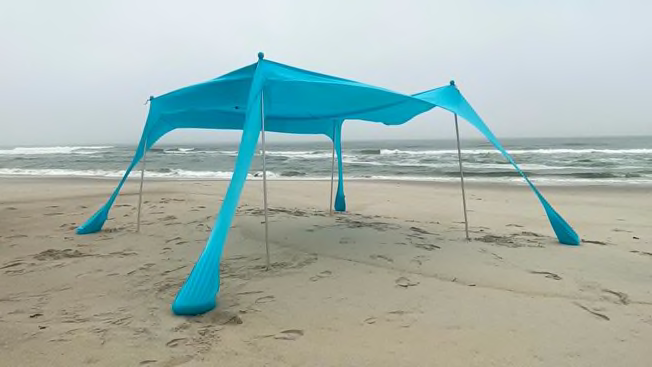
Setup time: 6 minutes, 13 seconds
Takedown time: 2 minutes, 3 seconds
If you’re sensing a theme here, it’s that we liked all of the canopies we evaluated. The Sun Ninja has a unique shape that gives us Salvador Dali vibes and is another canopy we’d gladly own, though we didn’t find it as easy to set up and take down as the CoolCabana 5.
Setup/takedown: This canopy comes in a carrying case with a shoulder strap and an instruction booklet tucked into a front pocket. It also includes more accessories than the CoolCabana 5 or Shibumi Shade, and it takes more time than the others to set up. Spread the canopy flat on the sand and attach four semi-attached poles together. According to Sun Ninja, you can set this up with two poles as long as you’re erecting it in the direction of the wind, but I recommend using all four poles to keep it steady.
Each pole features a large foam ball on one end, and this ball should be positioned at the corner of the underside of the canopy, near one of four long flaps that lead to large sand pockets. Once the pole is inserted into the sand, take one of the elastic drawstring ties, place it over the fabric with the foam ball protruding from underneath the fabric, and secure it in place. A large shovel is included with this canopy, which is a nice touch, and you’ll need it to fill its sand pockets with as much sand as they can fit. I had to reposition the poles and sandbags a few times before the canopy looked even and steady.
To take it down, empty the sandbags of sand, remove each elastic drawstring, and unattach and fold down each pole. The poles can be placed in two smaller carrying bags, and I found the canopy easily shook off loose sand and was thin enough to fit into the carrying bag without struggle.
Shade coverage: Even though the Shibumi Shade Classic offers 50 more square feet of shade coverage, the Sun Ninja Tent doesn’t rely on wind and seems to be, of the two, the one that offers the most consistent shade. Like the CoolCabana 5, there’s no mechanism for tilting the canopy to adjust for the sun’s changing angles.
Wind resistance: This canopy held its own as the wind blew. The poles didn’t tilt, and the canopy simply swayed with the breeze, but this didn’t affect shade coverage.
Features: This canopy is machine-washable. (According to CoolCabanas, its canopy provides protection from rain but isn’t waterproof, and I checked the instructions for both CoolCabanas and Shibumi, and neither provided cleaning instructions.) It’s made with spandex with triple overlock stitching—it’s on the thin side, but feels durable—and it also has UPF 50+ protection, according to the manufacturer. (CR didn’t evaluate this claim.)
Each of the two carrying bags for its poles features setup instructions, notes about troubleshooting, and even reminders to apply sunscreen right on the bags. You’re not limited to using this canopy on the beach, either. It comes with four metal stakes that can be attached to fabric hooks beneath the canopy’s sand pockets that secure it in dirt or grass. (CR didn’t evaluate the stakes.) The canopy comes in four colors and three sizes, including a mini canopy (Amazon, Walmart) for pets and toddlers and a medium-sized canopy (Amazon, Walmart) for four people.
What annoyed us: It would be nice to have some sort of detachable privacy shade for times when the sun’s angle is impossible to shield with the canopy. Also, the fact that this canopy comes with more components means it’s easier to lose them. With that said, Sun Ninja provides separate carrying bags for each accessory, so we really can’t complain much about this.
How We Evaluated Beach Canopies
We took our canopies to Long Beach, N.Y., on a windy morning in April. We evaluated their ease of setup, distinctive features, and their ability to provide consistent shade and wind resistance. Although each manufacturer provides the weight of its product, we weighed each canopy on our own using a scale that measures down to one-tenth of a gram. Our weight results reflect everything in the carrying bag that you would take with you to the beach and include the weight of the carrying bag, as well.











